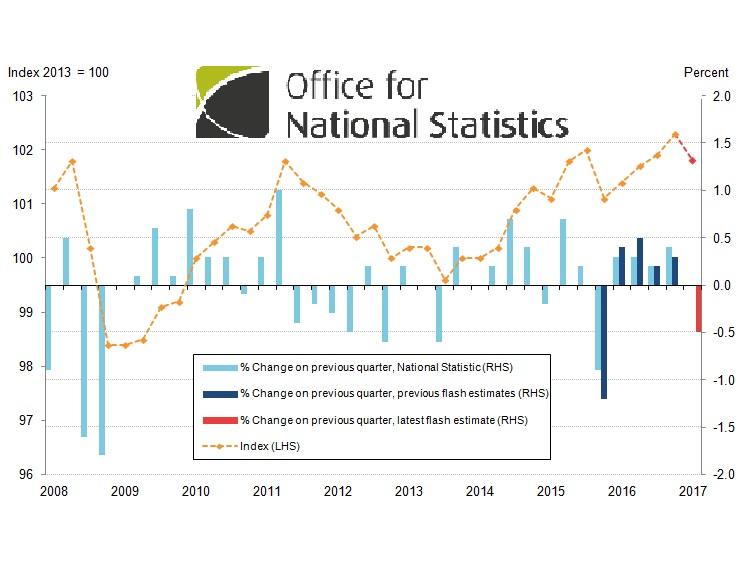UK Productivity falls by 0.5% – Sector Response

GREAT ON JOBS, POOR ON LIVING STANDARDS AND PRODUCTIVITY
 Commenting on the figures, Steve Hill, External Engagement Director at The Open University said:
Commenting on the figures, Steve Hill, External Engagement Director at The Open University said: Stephen Evans, Chief Executive at Learning and Work Institute , said:
Stephen Evans, Chief Executive at Learning and Work Institute , said:
“There’s something for both main parties in the last labour market stats before the General Election.
“The Conservatives will point to another record high in both employment and vacancies. These show the labour market shrugging off (so far) any worries about a slowdown in the economy.
“Labour will point towards the first fall in real wages since 2014, as inflation (2.7%) is now higher than wage growth (2.1%), and the fact productivity is no higher than it was before the crisis – a truly dismal performance.
“The truth is both are right and this is very much the post-2008 pattern: our economy is great at creating jobs, but has proven poor at raising living standards and productivity. This is the challenge for whoever forms the next government.
“The disability employment gap (relative to non-disabled) on latest data is 30.9% compared to 32.8% at the time of the 2015 General Election.”
UK productivity flash estimate: Jan to Mar 2017
 Output per hour – our main measure of labour productivity – fell by 0.5% in Quarter 1 (January to March) 2017. This compares with growth of 0.4% in Quarter 4 (October to December) 2016, as published in the April 2017 Productivity Bulletin.
Output per hour – our main measure of labour productivity – fell by 0.5% in Quarter 1 (January to March) 2017. This compares with growth of 0.4% in Quarter 4 (October to December) 2016, as published in the April 2017 Productivity Bulletin.
The fall in productivity in Quarter 1 was the result of slower gross value added (GVA) growth (using the preliminary gross domestic product (GDP) estimate) combined with an increase in total hours worked driven by growth in both employment and average weekly hours worked (using the latest Labour Force Survey data).
This flash estimate of UK productivity uses the first available information on output and labour input for the quarter. This data may be revised in subsequent months. As such, we release the more detailed Productivity Bulletin after the third estimate of GDP for the quarter is published, which will be consistent with the Quarterly National Accounts.
This is the first quarterly fall in output per hour since Quarter 4 (October to December) 2015, following 4 consecutive quarters of growth. UK productivity growth has been weak since the onset of the economic downturn in Quarter 1 2008 as a result of the relative strength of the labour market compared with GDP.
Both employment – which captures the total number of people in work – and total hours – which captures both changes in employment and working patterns – fell in the course of the economic downturn, but total hours fell further reflecting falls in the average hours of those in employment. However, as GDP fell by a larger proportion in the economic downturn than hours or employment and has grown slowly by historical standards during the recovery, productivity growth has been subdued since the downturn and has recovered more slowly than following previous downturns.
The fall in productivity in Quarter 1 was a result of hours worked growing faster than output; the most recent estimate of GDP indicated that the UK economy grew by 0.3% in Quarter 1 2017, the slowest rate of growth since Quarter 1 2016. In Quarter 1, output was 8.5% larger than the pre-downturn level of output in Quarter 1 2008.
Slower growth in Quarter 1 2017 was due mainly to services, which grew by 0.3% compared with growth of 0.8% in Quarter 4 2016. Production output grew by 0.3% – including manufacturing growth of 0.5% – while construction grew by 0.2% on the quarter.
The main contributor to the slowdown in services was the distribution, hotels and restaurants sector, the output of which decreased by 0.5% on the quarter, contributing negative 0.07 percentage points to quarter-on-quarter GDP growth. The output of the transport, storage and communications industries also decreased by 0.2% in Quarter 1 2017. However, the negative growth in these two sectors was more than offset by positive growth in government and other services (which grew by 0.5%) and business services and finance sectors (which saw growth of 0.7% over the quarter). Many of the biggest negative contributions in the services industries in Quarter 1 2017 came from consumer-focused industries, such as retail trade, accommodation, and the trade and repair of motor vehicles, which all decreased when compared with the previous quarter – this was due in part to prices increasing more than spending.
May’s UK Labour Market release shows that there were 31.9 million people aged 16 and over in work in Quarter 1 2017, which was 122,000 more than the previous quarter and 381,000 more than a year earlier. The negative growth in output per hour was caused by total weekly hours worked increasing by 0.8% on the quarter, reflecting an increase of 0.4% in both average weekly hours worked and employment.
GDP data is from the Gross Domestic Product: Preliminary Estimate – Quarter 1 (January to December) 2017 published on 28 April 2017.
Labour Market data is from the Labour Market Statistics – May 2017 published on 17 May 2017.
The Government’s digital report can be found here.











Responses